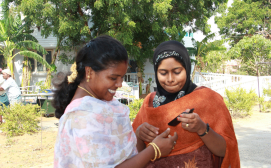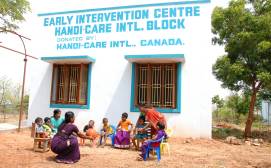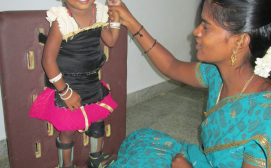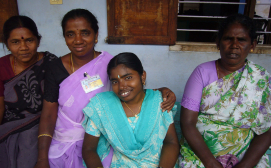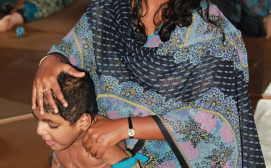Project Lead(s): Sankara Raman Srinivasan
Issue
More than six million children in India today live with a disability. The World Health Organization (WHO) 2011 report on disability emphasized that early intervention (EI) programs for developmentally delayed children under the age of five are critical to improving long-term function.
Unfortunately, EI therapy remains inaccessible for most children in rural India because they live too far from centres where rehabilitation specialists work. Lack of EI is associated with poor school integration, and the World Bank’s 2009 Report on People with Disabilities in India reported that 45% of children with disabilities in Tamil Nadu do not attend school, compared to 3% of children without disabilities.
Solution
The project team developed a mobile application, called mVBRI (Mobile Village Based Rehabilitation Initiative), and a SalesForce cloud-based data collection system to help Community Rehabilitation Workers (CRWs) communicate with rehab specialists located remotely, to provide early intervention therapy at home.
A total of 280 children under age six underwent home-based EI therapy, provided by CRWs assisted by the mVBRI application. In addition, 71 children underwent therapy at an Early Intervention Parents Participation Centre, where children and family support groups are brought to one central location for rehabilitation services.
Outcome
Using validated assessment tools, developmental scores were tracked for children pre- and post-therapy in various domains of development.
Data analysis showed statistically significant improvements in developmental scores overall for children in all functional categories involved. In addition, 38 children improved sufficiently to be enrolled in neighborhood government schools.
The dashboard feature of the mVBRI app showed that 73% of planned home or parent participation centres therapy visits occurred (the goal was 65%) and all enrolled children are still actively involved in the EI program.
Other positive outcomes from the program included:
· Ability to plan, schedule and monitor work of the CRWs
· Paperless data management
· Increased productivity and proactive program management
· Professional guidance of therapy from rehabilitation professionals without frequent travel to the field
· Increased effectiveness in program delivery, as reflected in high participation and engagement rates, and parent feedback reports
· Promotion of greater engagement of people with disability and special needs in society.
The team found that the application can be used not only for EI services, but for all clients with disabilities that Amar Seva Sangam serves through village-based rehabilitation.
The team plans to apply for Transition to Scale (TTS) Phase II funding, in order to expand the services to all 434 children that have been identified as needing EI therapy in the surrounding communities.
They then hope to expand their services to even more communities and to provide access to therapy for 700 children.
In addition, they plan to expand the mVBRI app to cover all 2,187 people with disabilities under their village-based rehab program, with the goal being to eventually expand these EI services to the entire state of Tamil Nadu.
Based on the successful implementation of this project, the project has been able to secure additional funding from: Handi-Care Intl., Om Charity Trust and Sri Dorabji Tata Trust

